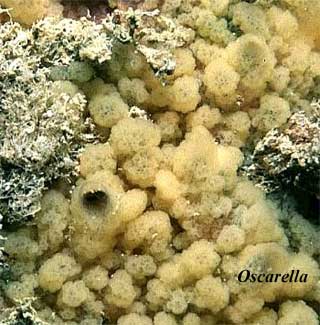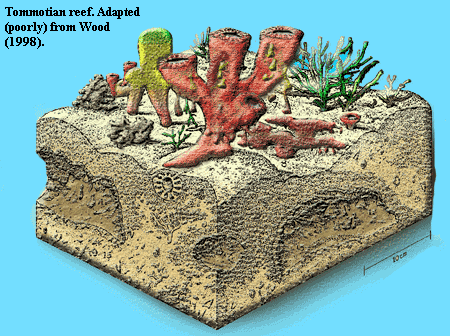 2) The Calcarea are an early branch.
2) The Calcarea are an early branch.| Porifera | ||
| Porifera | Porifera - 3 |
| Metazoa | Metazoa | Metazoa | ||||
| Time |
|
Metazoa
├─Choanoflagellata
└─Porifera
├─Archaeocyatha
└─┬─Stromatoporoidea
└─┬─Calcarea
└─┬─Hexactinellida
└─┬─Demospongiae
│ ├─Tetractinomorpha
│ └─Ceractinomorpha
└─┬─Homoscleromorpha
└─Eumetazoa
|
Introduction
|
A majority of sponge people would probably agree on the following propositions:
1) The Hexactinellida are one of the most ancient group of living sponges.
 2) The Calcarea are an early branch.
2) The Calcarea are an early branch.
3) The "Scleractinellida" or "Sclerospongia" are a polyphyletic group and should be abandoned.
4) Most of the better-known extinct forms (e.g. Archaeocyatha, Stromatoporoidea) are probably either stem group sponges or stem group demosponges.
See, e.g., Schütze et al. (1998)
Thus our sponge cladogram might look something like this:
Then again, it might not look like that. This arrangement is something of a compromise between some of the currently respectable views and our own, pointless speculation (which is taken up later). Not that there is any lack of other opinions. For example, it is still possible, even today, to find otherwise rational people who believe they can read the far future using tea leaves and the deep past using mitochondrial DNA. Thus Wang & Lavrov (2007),  having performed the appropriate rites, recently found that Porifera and Cnidaria form a monophyletic group to the exclusion of bilaterians. These authors unaccountably failed to include any Hexactinellida or Calcarea in the analysis. Since the Porifera are often believed to be paraphyletic, it's a bit hard to draw any conclusions about phylogeny without sampling these taxa, even supposing that one could place any confidence in this methodology [1].
having performed the appropriate rites, recently found that Porifera and Cnidaria form a monophyletic group to the exclusion of bilaterians. These authors unaccountably failed to include any Hexactinellida or Calcarea in the analysis. Since the Porifera are often believed to be paraphyletic, it's a bit hard to draw any conclusions about phylogeny without sampling these taxa, even supposing that one could place any confidence in this methodology [1].
In fairness to Wang & Lavrov, their interest was not in sponge phylogeny in general, but the placement of a particular group, the Homoscleromorpha, represented in their work by Oscarella carmela. The homoscleromorphs were once assumed to be demosponges. However, recent morphological work has shown that they have some important characters thought to be unique to the Eumetazoa (= Cnidaria + Bilateria). Specifically, homoscleromorphs have a basement membrane underlying both the pinacoderm and the choanoderm. Boute et al. (1996). That is, they have a true epithelium. In addition, their spermatozoa have an acrosome. They share some unique structural features of the embryonic flagellum with Calcarea. [14] Finally, Wang & Lavrov show that Oscarella also has a distinctive organization of its mitochondrial DNA, with half the genes read in one direction and half in the opposite direction. This is unique among sponges, but similar to certain cnidarians.
This raises the distinct possibility that the Homoscleromorpha are a fourth group of sponges diverging from the main stem. While such a relationship was not recovered by Wang & Lavrov, it was found by Sperling et al. (2006), using a battery of nuclear genes coding for a number of enzymes and structural proteins involved in general metabolism. Unfortunately, Sperling et al. also omit hexactinellids from their study it seems that hexactinellid DNA is very hard to come by). However, they do, indeed recover Homoscleromorpha as a fourth sponge group.
But Sperling & Co. are not yet done grafting branches onto the sponge tree. One perennial problem in poriferan taxonomy has been the inclusion (vel non) of the Chancelloriidae, an orphan group of sponge-like Cambrian cucumbers with spicules (image from Bengtson, 2000). Sperling et al. argue that they are sponges. Chancelloriid spicules are said to be un-sponge-like. Sperling dismisses this objection, pointing out that the paraphyly of sponges requires us to accept that spicules were independently developed at least three times [3]. Thus a fourth independent invention by chancelloriids shouldn't be a cause for concern. In particular, Sperling points out that the developmental process for silicate spicules (hexactinellids, demosponges and homoscleromorphs) is different from the process for making calcareous spicules (Calcarea). Silicate spicules are made inside the cell, pre-patterned on an organic matrix. Calcareous spicules are formed outside the cell and constitute a single crystal of calcium carbonate. In addition, there are other sponges that have no spicules at all (keratose demosponges), and yet others which form a massive, interconnected "shell." But c.f. Botting & Butterfield (2005).
Sperling's group places Homoscleromorpha between the Calcarea and Eumetazoa. For reasons discussed in tiresome detail elsewhere, we disagree, believing that they are related more closely to demosponges. Then, accepting that homoscleromorphs are more closely related to non-sponge animals than areother sponges our cladogram might ultimately look a bit like this:

Additional details and discussion on the shape of sponge phylogeny may be found elsewhere. Again, this arrangement reflects a compromise between an outline which is widely accepted and probably correct, and certain aberrant ideas which we will do our best to bolster in the sections which follow. ATW080104.
 Sponges have played a critical role in shaping the basic form of the Phanerozoic biosphere. Archaeocyaths and perhaps even some Calcarea formed the first major biological reef systems in the middle Tommotian. Sponges seemed to have played an important role in most reef systems thereafter, and have been critical in maintaining reef systems during certain times of biological crisis (Vishnevskaya et al., 2002 -- Late Devonian).
Sponges have played a critical role in shaping the basic form of the Phanerozoic biosphere. Archaeocyaths and perhaps even some Calcarea formed the first major biological reef systems in the middle Tommotian. Sponges seemed to have played an important role in most reef systems thereafter, and have been critical in maintaining reef systems during certain times of biological crisis (Vishnevskaya et al., 2002 -- Late Devonian).
page ATW070807
checked ATW070725,
last modified ATW080104